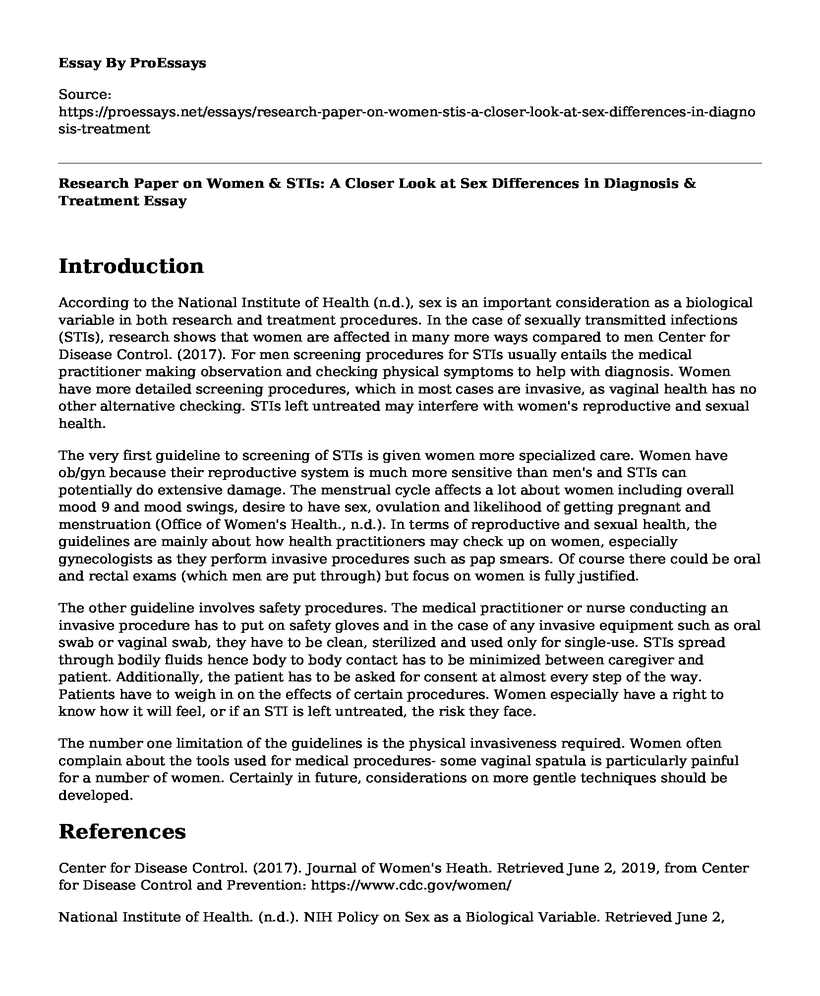Introduction
According to the National Institute of Health (n.d.), sex is an important consideration as a biological variable in both research and treatment procedures. In the case of sexually transmitted infections (STIs), research shows that women are affected in many more ways compared to men Center for Disease Control. (2017). For men screening procedures for STIs usually entails the medical practitioner making observation and checking physical symptoms to help with diagnosis. Women have more detailed screening procedures, which in most cases are invasive, as vaginal health has no other alternative checking. STIs left untreated may interfere with women's reproductive and sexual health.
The very first guideline to screening of STIs is given women more specialized care. Women have ob/gyn because their reproductive system is much more sensitive than men's and STIs can potentially do extensive damage. The menstrual cycle affects a lot about women including overall mood 9 and mood swings, desire to have sex, ovulation and likelihood of getting pregnant and menstruation (Office of Women's Health., n.d.). In terms of reproductive and sexual health, the guidelines are mainly about how health practitioners may check up on women, especially gynecologists as they perform invasive procedures such as pap smears. Of course there could be oral and rectal exams (which men are put through) but focus on women is fully justified.
The other guideline involves safety procedures. The medical practitioner or nurse conducting an invasive procedure has to put on safety gloves and in the case of any invasive equipment such as oral swab or vaginal swab, they have to be clean, sterilized and used only for single-use. STIs spread through bodily fluids hence body to body contact has to be minimized between caregiver and patient. Additionally, the patient has to be asked for consent at almost every step of the way. Patients have to weigh in on the effects of certain procedures. Women especially have a right to know how it will feel, or if an STI is left untreated, the risk they face.
The number one limitation of the guidelines is the physical invasiveness required. Women often complain about the tools used for medical procedures- some vaginal spatula is particularly painful for a number of women. Certainly in future, considerations on more gentle techniques should be developed.
References
Center for Disease Control. (2017). Journal of Women's Heath. Retrieved June 2, 2019, from Center for Disease Control and Prevention: https://www.cdc.gov/women/
National Institute of Health. (n.d.). NIH Policy on Sex as a Biological Variable. Retrieved June 2, 2019, from National Institutes of Health Office on Research of Women's Health: https://orwh.od.nih.gov/sex-gender/nih-policy-sex-biological-variable
Office of Women's Health. (n.d.). Fact Sheet on STIs. Retrieved June 2, 2019, from Office of Women's Health: https://www.womenshealth.gov/files/documents/fact-sheets-stis.pdf
Cite this page
Research Paper on Women & STIs: A Closer Look at Sex Differences in Diagnosis & Treatment. (2023, Jan 16). Retrieved from https://proessays.net/essays/research-paper-on-women-stis-a-closer-look-at-sex-differences-in-diagnosis-treatment
If you are the original author of this essay and no longer wish to have it published on the ProEssays website, please click below to request its removal:
- Paper Example on the Health Acquired Pressure Ulcer Issue
- Facility Assessment: Gernon Brown Recreation Center
- Quality and Safe Care Essay Example
- Essay on Aging Care in Australia: Need for Increased Spending for Justice
- Essay Example on US Flu Surveillance Data Unreliable: Estimates Used Instead of Cases
- Essay Example on Diabetes: Type 1 and Type 2 Overview
- Essay Example on Pandemic Highlights Online Potential for Colleges and Universities







